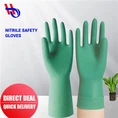Core tip: gloves are the most protective tool used in the laboratory except goggles. There are many kinds of gloves, and different gloves have different uses.
Natural rubber (latex)
Natural rubber latex gloves are usually unlined and come in a variety of styles, including clean style and sterile style. These gloves can provide effective protection against alkalis, alcohols, and various chemical dilute aqueous solutions, and can better prevent the corrosion of aldehydes and ketones.
PVC gloves
Gloves do not contain allergens, have no powder, low dust generation, low ion content, strong chemical corrosion resistance, can protect almost all dangerous chemicals, and also have anti-static properties. The thickened and treated surface (such as rough surface) can also prevent general mechanical wear, and the thickened type can also prevent cold, and the operating temperature is - 4 ℃~66 ℃. It can be used in a dust-free environment.
Grading standard for PVC gloves:
Grade A product, the glove surface has no holes (PVC gloves with powder), the powder amount is even, there is no obvious powder, the color is transparent milky white, there is no obvious ink spots, no impurities, and the size and physical properties of each part meet the customer's requirements.
Grade B product, slight stain, 3 small black spots (1mm ≤ diameter ≤ 2mm), or large number of small black spots (diameter ≤ 1mm) (diameter>5), deformation, impurities (diameter ≤ 1mm), slightly yellow color, severe nail prints, cracks, and the size and physical properties of each part do not meet the requirements.
PE gloves
PE gloves are disposable gloves made of polyethylene. It has the functions of waterproof, anti oil stain, anti bacteria, acid and alkali resistance. Tips: Generally speaking, PE gloves can touch food and are non-toxic; PVC gloves should not touch food, especially hot food.
Nitrile rubber gloves
Nitrile rubber gloves are generally divided into disposable gloves, medium unlined gloves and light lined gloves, which can prevent the corrosion of grease (including animal fat), xylene, polyethylene and aliphatic solvent; It also prevents the use of most pesticide formulations, commonly used in the use of biological components and other chemicals. Nitrile rubber gloves do not contain protein, amino compounds and other harmful substances, and rarely cause allergy. Silicon free, with certain anti-static performance, suitable for the production needs of the electronic industry. Low surface chemical residues, low ion content, small particle content, suitable for strict clean room environment.
Neoprene gloves
Similar to the comfort of natural rubber, neoprene gloves are resistant to light, aging, bending, acid and alkali, ozone, combustion, heat and oil.
Butyl rubber gloves
Butyl rubber is only used as the material of medium unlined gloves, and can be used for glove box, anaerobic box, incubator and operation box; It has super durability to fluoric acid, aqua regia, nitric acid, strong acid, strong base, toluene, alcohol, etc. It is a special rubber synthetic resistant liquid glove.
Polyvinyl alcohol (PVA) gloves
Polyvinyl alcohol (PVA) can be used as the material of medium-sized lined gloves, so this kind of gloves can provide a high level of protection and corrosion resistance against a variety of organic chemicals, such as aliphatic, aromatic hydrocarbons, chlorinated solvents, fluorocarbons and most ketones (except acetone), esters and ethers.
Do you wear the correct seven commonly used gloves in the laboratory?
Dec 28, 2022Leave a message
Send Inquiry




